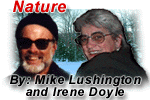|
 Nature's Sure Signs
Nature's Sure Signs
by: Mike Lushington
In recent weeks, I have been approached by several people who wanted
to ask me to help them with an identification of a bird that they had seen
- in their backyards, or down at the beach,or back in the woods. In each
case, they were quite convinced that they had never seen this particular
bird previously, and, on those occasions when we were able to puzzle out
an identification, were surprised to discover that the bird was, in fact,
quite common locally. All of this points to a very simple, but very
pleasant fact: more and more people are paying attention to the things
that they see around them, and becoming curious as to what those things
actually are. With that in mind, I thought to offer the following bits of
information.
I sometimes ask people how many different species they think we might
find around here in the course of a year. Often, they guess that the
number might be fifty or sixty, and are rather amazed when I tell them
that I identify more than one hundred and fifty species annually, and
that, over the course of the years, have accumulated a Restigouche County
list that has around two hundred and forty species on it.
Part of that number comes about simply by realizing that, instead of
there being one "seagull", there are actually six species of gull that
visit annually, and a couple more that do so from time to time. Looking
over the birds down at The Bar, at the sewage treatment lagoon, around the
Bon Ami Rocks and in the river around home, I have been able to identify
more than thirty species of ducks and geese. We have some twenty species
of warblers, perhaps ten sparrows, another ten of finches, five or six
woodpeckers, and several species of owls and hawks. Add the thrushes, the
different sorts of shorebird, and the miscellaneous other species around,
and it becomes more evident that the more one learns, the more there is to
learn.
I am always happy to try to help someone figure out just what it is
that he or she has seen. However, in order to do that, it is most helpful
if the observer can supply the following bits of information:
- How big was the bird in relation to one of the very common birds that
we see all the time? In other words, was it the size of a sparrow? a
robin? a crow? a duck or goose?
- Where exactly was the bird? on the ground? in a tree? in brush?,br>
- What was it doing? Was it pecking in the ground, looking for insects?
Was it chasing other birds? Was it eating seeds, or berries?
- Could the observer see any outstanding marks or patterns on the bird?
Did it have a crest? Did it have a particularly bright wing patch or tail
colouring?
The more that one can see and remember, the easier it is to come up
with at least a tentative identification. Having a good bird guide handy
is helpful for many people, but by far the more important tool is a good,
objective pair of eyes. The person who sees as much as he or she can, and
who remembers that (or makes notes while the image is still fresh) is far
more likely to come up with a positive identification than someone who
allows time and an active imagination to colour the original sighting.
|